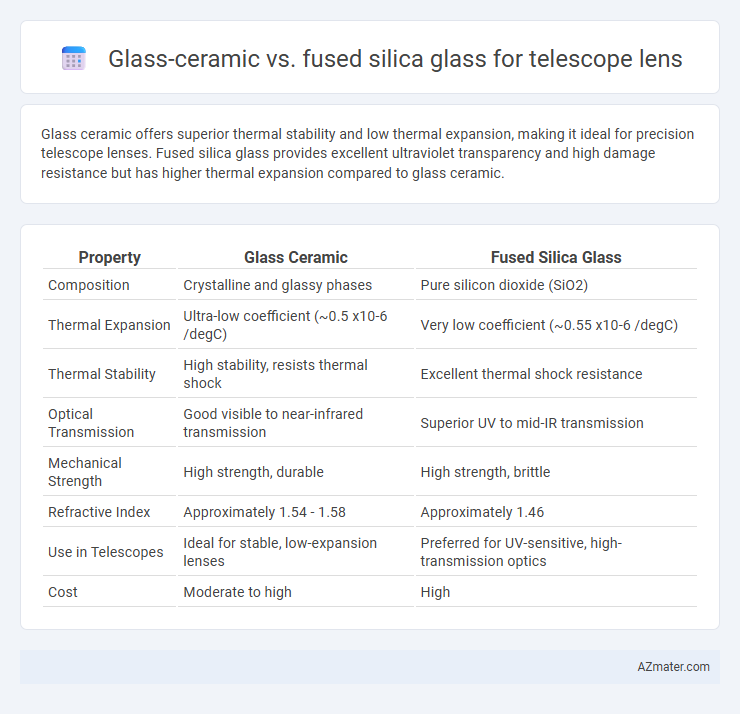Glass ceramic offers superior thermal stability and low thermal expansion, making it ideal for precision telescope lenses. Fused silica glass provides excellent ultraviolet transparency and high damage resistance but has higher thermal expansion compared to glass ceramic.
Table of Comparison
| Property | Glass Ceramic | Fused Silica Glass |
|---|---|---|
| Composition | Crystalline and glassy phases | Pure silicon dioxide (SiO2) |
| Thermal Expansion | Ultra-low coefficient (~0.5 x10-6 /degC) | Very low coefficient (~0.55 x10-6 /degC) |
| Thermal Stability | High stability, resists thermal shock | Excellent thermal shock resistance |
| Optical Transmission | Good visible to near-infrared transmission | Superior UV to mid-IR transmission |
| Mechanical Strength | High strength, durable | High strength, brittle |
| Refractive Index | Approximately 1.54 - 1.58 | Approximately 1.46 |
| Use in Telescopes | Ideal for stable, low-expansion lenses | Preferred for UV-sensitive, high-transmission optics |
| Cost | Moderate to high | High |
Introduction to Telescope Lens Materials
Glass ceramic and fused silica glass are prominent materials used in telescope lenses due to their distinct optical properties and thermal stability. Glass ceramics exhibit low thermal expansion and high resistance to thermal shock, enhancing image stability during temperature fluctuations. Fused silica glass offers exceptional optical clarity, high transmission in the ultraviolet to infrared spectrum, and excellent homogeneity, making it ideal for precision astronomical lenses.
What is Glass Ceramic?
Glass ceramic is a composite material combining the properties of both glass and crystalline ceramics, created through controlled crystallization of certain glass formulations. It offers exceptional thermal stability, low thermal expansion, and high strength, making it ideal for precision telescope lenses that require minimal distortion under temperature changes. Compared to fused silica glass, glass ceramic provides enhanced dimensional stability and reduced susceptibility to thermal shock, improving optical performance in varying environmental conditions.
What is Fused Silica Glass?
Fused silica glass is a high-purity, non-crystalline form of silicon dioxide known for its exceptional thermal stability, low thermal expansion, and excellent optical transparency across a wide wavelength range, making it ideal for telescope lenses. Compared to glass ceramic, fused silica offers superior resistance to thermal shock and minimal optical distortion, enhancing image clarity in precision astronomical observations. Its ultra-low coefficient of thermal expansion ensures stable focal length and minimal aberration, critical for maintaining optimal telescope performance.
Optical Properties Comparison
Glass ceramic offers superior thermal stability and lower thermal expansion compared to fused silica glass, minimizing distortion during temperature fluctuations in telescope lenses. Fused silica glass delivers exceptional ultraviolet (UV) transmission and high homogeneity, providing clear and sharp images with minimal chromatic aberration. Both materials exhibit excellent optical clarity, but fused silica's higher resistance to laser damage makes it preferable for high-intensity light applications in advanced telescopes.
Thermal Expansion and Stability
Glass ceramic exhibits exceptionally low thermal expansion coefficients, often close to zero (e.g., Zerodur with ~0 +- 0.007 x 10^-6 /degC), ensuring superior dimensional stability under temperature fluctuations, which is critical for maintaining precise telescope lens alignment. Fused silica glass, with a slightly higher thermal expansion coefficient around 0.5 x 10^-6 /degC, offers excellent thermal stability but can still undergo minor distortions under rapid temperature changes. The near-zero thermal expansion of glass ceramic makes it more advantageous for high-precision telescopic applications where minimizing focus shift and maintaining optical performance in varying thermal environments is essential.
Mechanical Strength and Durability
Glass ceramics offer higher mechanical strength and superior resistance to thermal shock compared to fused silica glass, making them more durable under varying environmental conditions. Fused silica glass exhibits excellent chemical stability and low thermal expansion but is generally more brittle, increasing the risk of fracture under mechanical stress. Telescope lenses made from glass ceramics benefit from enhanced longevity and structural integrity in demanding observational environments.
Transmission and Wavelength Range
Glass ceramic materials used in telescope lenses typically offer moderate transmission with strong durability but have a narrower effective wavelength range compared to fused silica glass. Fused silica glass provides superior ultraviolet to near-infrared transmission, spanning approximately 185 nm to 2500 nm, making it ideal for high-precision astronomical observations requiring minimal signal loss. The low thermal expansion and high homogeneity of fused silica enhance image clarity and maintain optical performance across broad wavelength ranges, outperforming many glass ceramics in transmission efficiency.
Cost and Manufacturing Considerations
Glass ceramic materials offer cost advantages over fused silica glass due to lower raw material expenses and simpler manufacturing processes, making them suitable for budget-sensitive telescope lens production. Fused silica glass, while more expensive because of its high purity and specialized fabrication techniques, provides superior thermal stability and optical clarity critical for high-precision astronomical observations. Manufacturing fused silica lenses involves complex melting and forming procedures that increase production time and cost, whereas glass ceramics can be produced with quicker, less energy-intensive methods enhancing scalability.
Typical Applications in Astronomy
Glass ceramic lenses in telescopes are preferred for high-precision astronomical imaging due to their superior thermal stability and low thermal expansion, which minimizes distortion during temperature fluctuations. Fused silica glass lenses are widely used in ultraviolet and infrared telescope systems for their excellent transmission properties across a broad spectral range, enhancing observations of faint celestial objects. Both materials are critical in astronomical instrumentation, with glass ceramics favored for structural components and fused silica for optical elements requiring high purity and minimal optical aberrations.
Choosing the Right Material for Telescope Lenses
Glass ceramic offers superior thermal stability and low thermal expansion, minimizing focus shifts during temperature changes in telescope lenses. Fused silica glass provides exceptional optical clarity and high transmission in ultraviolet and infrared wavelengths, ideal for high-precision astronomical observations. Selecting between glass ceramic and fused silica depends on balancing thermal performance with spectral requirements to optimize telescope lens functionality.

Infographic: Glass ceramic vs Fused silica glass for Telescope lens
 azmater.com
azmater.com